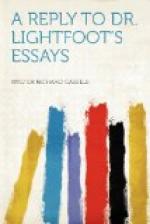Illustrations of this kind could be indefinitely multiplied, and to anyone who has studied the three synoptics, with their similarities and variations, and considered the probable mode of their compilation, it must be apparent that, with the knowledge that very many other Gospels existed (Luke i. 1), which can only very slowly have disappeared from circulation, it is impossible for anyone with a due appreciation of the laws of evidence to assert that the use of short passages similar to others in our Gospels actually proves that they must have been derived from these alone, and cannot have emanated from any other source. It is not necessary to deny that they may equally have come from the Gospels, but the inevitable decision of a judicial mind, seriously measuring evidence, must be that they do not absolutely prove anything.
Coming now more directly to the essay on “The later school of St. John,” it is curious to find Dr. Lightfoot setting in the very foreground the account of Polycarp’s martyrdom, without a single word regarding the more than suspicious character of the document, except the remark in a note that “the objections which have been urged against this narrative are not serious.” [135:1] They have been considered so by men like Keim, Schuerer, Lipsius, and Holtzmann. The account has too much need to be propped up itself to be of much use as a prop for the Gospels. Dr. Lightfoot points out that an “idea of literal conformity to the life and Passion of Christ runs through the document,” [135:2] and it is chiefly on the fact that “most of the incidents have their counterparts in the circumstances of the Passion, as recorded by the synoptic evangelists alone or in common with St. John,” that he relies, in referring to the martyrdom. I need scarcely reply that not only, on account of the very doubtful character of the document, is it useless to us as evidence, but because it does not name a single Gospel, much less add anything to our knowledge of their authorship and trustworthiness. I shall have more to say regarding Dr. Lightfoot in connection with this document further on.




